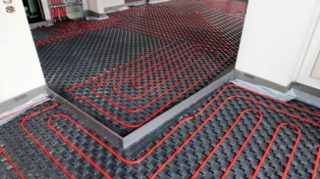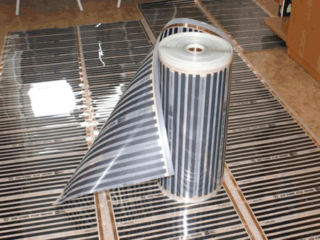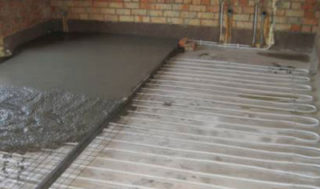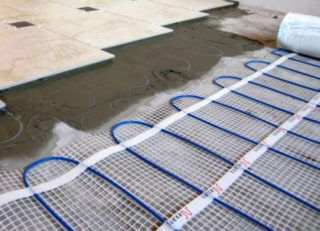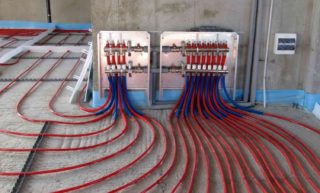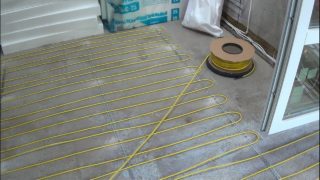The room can be heated with batteries, convectors or make the entire floor surface a source of energy. In the latter case, the homeowner gets extra comfort from touching his feet on a heated surface. The price of pleasure is the arrangement of a more complex system. For everything to work correctly, the technology for laying a warm floor must be followed. It has its own characteristics for each type of such heating.
Options for underfloor heating
Depending on the tasks, you can lay the heater on the entire area of the room or locally, only in those areas where there will be direct contact with it. There are three known options for home improvement with a heating system of this type:
- by water according to the principle of steam heating;
- electric heating cable;
- infrared film.
Most often, in apartments and houses, heating elements are mounted in the base of those rooms where it is supposed to lay ceramic tiles - in bathrooms, kitchens and dining rooms.
Floor heating with water pipes
The system is a circuit that is filled with concrete screed. The basis for a warm water floor is a layer of thermal insulation. Pipes here are located in parallel at a certain distance from each other over the entire area. Due to the operation of the circulation pump in the heater, the coolant moves, which is previously heated in the boiler. The concrete surface is in contact with the floor and the air in the room - this is how the room is heated.
Elements that are included in the heating system:
- boiler - gas, electric or solid fuel;
- pipe for supplying coolant;
- circulation pump;
- distribution node, in which there is a collector that allows you to configure each branch of the circuit and the mixer;
- heater pipe;
- return line.
Water underfloor heating is called conditionally; a special antifreeze can be used as a liquid.
Electric cord as a warm floor
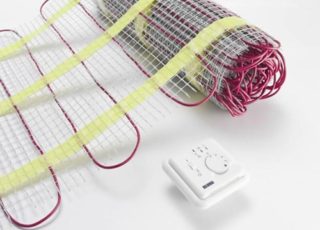
Heating in this way is based on laying a special heating cable of a resistive type in the thickness of a cement screed or adhesive for ceramic tiles. The heating conductors of the wire are equipped with a special end sleeve for connecting to the network. The heater can be used as the main source of energy or in tandem with others.
The electric heating system is similar to the liquid (by the principle of location) circuit, which is mounted in the base of the room. The power and pitch of the cord are affected by the type of finish coating and the depth of the wire. A properly organized circuit should warm the house well and evenly.
Manufacturers of quality cord adhere to the following European standards: EN 60811-506, EN 60335-2-96, EN 60335-1, IEC 60800.
Infrared film underfloor
It is a film consisting of two layers, inside of which there is a deposition of a heating element of a carbon material. The film thickness reaches only 0.5 millimeters. This makes it possible to stack it without changing the height of the room. From the heater to the network, electricity is supplied by copper foil.
The running meter of the film already has a certain power, so there is no need to measure the distance between the heaters - they are stacked butt to each other. If you want to create more or less thermal effect, this is achieved by choosing the appropriate substrate power.
The advantage of an infrared film for heating is that it can be laid on any horizontal and vertical surfaces.
Strengths and weaknesses of the heating method
The system provides the following benefits:
- An increased level of a sense of comfort, including with a tactile touch.
- The temperature of the heater is relatively low, if we correlate it with the temperature of radiators and convectors.
- The hidden installation which is not demanding attraction of any additional decorating materials.
- The possibility of using temperature controllers with wide functionality.
- Duration of service reaches an average of fifty years.
The disadvantages of this type of heating include:
- The complexity of the organization of installation with the need to raise the base of the room.
- Not any type of topcoat may be applicable in such a system.
- The heating is inertial in nature and can bring the room into normal temperature for 5 hours.
- People suffering from foot diseases, especially varicose problems, are not recommended to stay in a room with this type of heating for a long time.
- Heating synthetic materials leads to the evaporation of harmful substances.
A large heating area dries the air very much and requires the use of humidity control devices.
Comparative analysis
The water floor has the most complex type of construction and is very laborious to organize. There may be restrictions on the installation of such heating in multi-storey buildings due to the danger of heat transfer from the upper floors to the lower. In terms of energy efficiency, it can be more profitable than electrical and its service life is also higher.
The electric heating circuit based on the resistive cord has a simplified type of installation and does not require strict horizontal installation, like liquid. The cost of its installation is also less, it can be covered with tile glue almost at the surface of the floor covering. The service life of an electric heater is less than that of a liquid heater, and it creates magnetic waves that are harmful to humans.
The infrared emitter outperforms the two previous options with simplicity and low installation costs. It can be put directly under the tile, laminate or linoleum. In terms of energy efficiency, it is 60% more practical than a coil based on a heating cord.
Installation technology and features of the water floor device
Considering the cake that the water heater consists of, we can distinguish the following layers:
- In the lower part there is a layer of insulation from 5 to 20 cm thick, depending on which floor the room is on.
- Next comes a special plastic film, on it a dimensional grid for ease of installation - its thickness is approximately 4 mm.
- A pipe is fixed on top, which is poured on top with a screed.
- A damper tape up to 20 cm high should go along the perimeter of the entire pie room.
When laying underfloor heating using technology, the following points should be considered:
- Contour elements must be set horizontally strictly in level. This will minimize the risk of air congestion inside.
- Each individual circuit is recommended to be made integral, avoiding the joints of pipes under concrete.
- Before filling the heater with a solution, they pressurize the line - fill it with water heated to operating temperature and increase the pressure. During the day, observe that there are no leaks.
- The screed is poured when the system is filled with water and its temperature is within 25 degrees. This helps to stabilize the pipe and evenly harden the screed.
- The object can be used no earlier than 30 days after the concrete solidifies.
The pipe should lie from the surface of the screed at a depth of 5 centimeters - this is a condition for the correct operation of the thermal circuit.
Technology for laying electric floor heating
After rough work in the room - applying plaster on the walls, puttying the ceiling and pouring screed - you can begin to organize heating based on a heating cord. Stages of work:
- The base of the floor is free from foreign objects, dust and debris.
- A thermal insulation layer of expanded polystyrene from 3 to 10 cm thick is laid on top of the concrete, depending on whether the underground space is heated or not.
- In a convenient place on the wall, a temperature controller is mounted at a distance of about or above 30 cm above the final surface of the floor, a temperature sensor is connected to it, which is laid on the floor no closer than 50 cm from the wall with a temperature controller.
- The heating cord on the base of the grid is laid out over the area, avoiding those places where plumbing and furniture will be located in the future.
- The cable is connected to the thermostat.
- Screed is poured on top.
The laying of the infrared emitter is carried out with the difference that it is permissible to place the film under the furniture and fixtures and there is no need to cover it with a layer of concrete, you can immediately install the floor covering.

